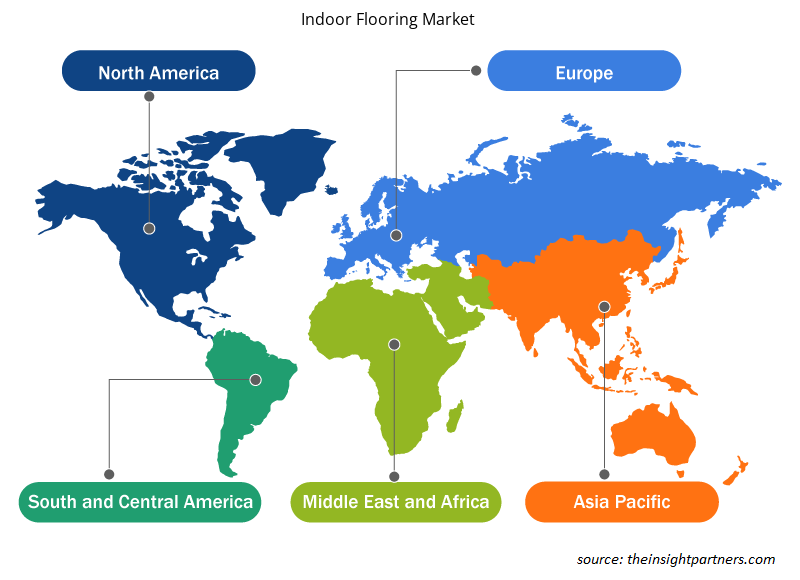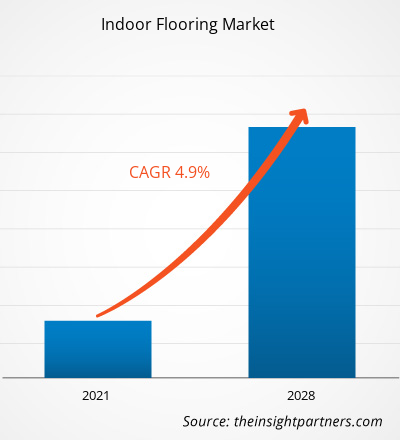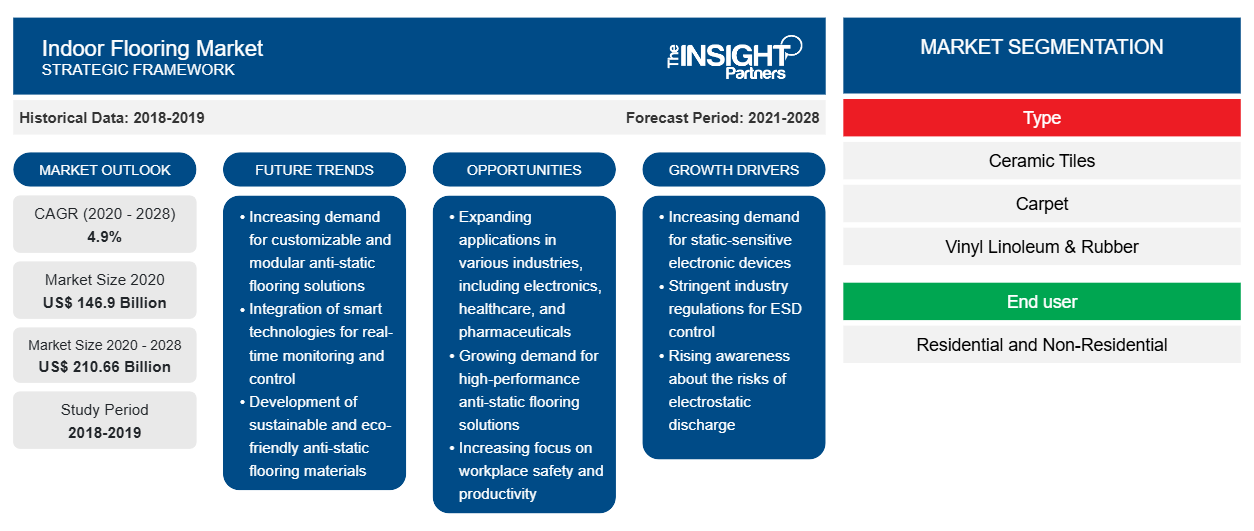[تقرير بحثي] بلغت قيمة سوق الأرضيات الداخلية 146.90 مليار دولار أمريكي في عام 2020، ومن المتوقع أن تنمو بمعدل نمو سنوي مركب قدره 4.9٪ خلال الفترة المتوقعة من 2021 إلى 2028.
في البيئات الصناعية مثل المستودعات وحظائر الطائرات ومصانع التجميع وورش الطلاء وورش الهياكل ومرافق التوزيع، تتعرض الأرضيات الخرسانية للتآكل والتلف نتيجة التعرض للمواد الكيميائية والزيوت القاسية والتآكلية؛ كما يمكن أن تتلف أيضًا بسبب الخدوش والجروح الناجمة عن الآلات والمعدات الثقيلة مثل الطائرات والرافعات الشوكية.
إن التصنيع السريع وإنشاء مصانع التصنيع والمعالجة في الاقتصادات النامية في منطقة آسيا والمحيط الهادئ يدفع الطلب على طلاءات الأرضيات، وتشكل صناعات الأدوية والأغذية والمشروبات وتجميع السيارات أهم مصادر الطلب. كما تعمل الشركات المتعددة الجنسيات في أوروبا وأمريكا على توسيع عملياتها في البلدان النامية في منطقة آسيا والمحيط الهادئ مثل الصين والهند. ومع قيام الشركات المصنعة الشهيرة بإنشاء مرافقها التشغيلية في البلدان في هذه المنطقة، فإن الطلب على طلاءات الأرضيات الصناعية يتزايد أيضًا. وقد شجع ارتفاع الطلب مصنعي الأرضيات الداخلية على تقديم منتجات متقدمة وعامة، وبالتالي دفع سوق الأرضيات الداخلية إلى الأمام.
قم بتخصيص هذا التقرير ليناسب متطلباتك
ستحصل على تخصيص لأي تقرير - مجانًا - بما في ذلك أجزاء من هذا التقرير، أو تحليل على مستوى الدولة، وحزمة بيانات Excel، بالإضافة إلى الاستفادة من العروض والخصومات الرائعة للشركات الناشئة والجامعات
- احصل على أهم اتجاهات السوق الرئيسية لهذا التقرير.ستتضمن هذه العينة المجانية تحليلاً للبيانات، بدءًا من اتجاهات السوق وحتى التقديرات والتوقعات.
تأثير جائحة كوفيد-19 على سوق الأرضيات الداخلية
لقد أثر تفشي فيروس كورونا المستجد بشكل كبير على تطوير البنية التحتية والاقتصاد العالمي. إن الاستجابة الدولية للاضطرابات السريعة التي لحقت بقطاعات وصناعات البنية التحتية الرئيسية مستمرة. وفقًا لأحدث تقرير حالة من منظمة الصحة العالمية، فإن الولايات المتحدة والهند والبرازيل وروسيا والمملكة المتحدة وفرنسا وإسبانيا وإيطاليا من بين الدول الأكثر تضررًا بسبب تفشي فيروس كورونا المستجد. بدأ تفشي المرض لأول مرة في ووهان (الصين) في ديسمبر 2019، ومنذ ذلك الحين انتشر في جميع أنحاء العالم. أثرت أزمة فيروس كورونا المستجد على الصناعات في جميع أنحاء العالم. تأثر الاقتصاد العالمي سلبًا في عام 2020، ومن المرجح أن يستمر في عام 2021. لقد أزعج الوباء شركات وموردي الأرضيات الداخلية في جميع أنحاء العالم. عانى اللاعبون في السوق من اضطرابات في عملياتهم، ومن المرجح أن يواجهوا عواقب حتى منتصف عام 2021. أثرت عمليات إغلاق المصانع وحظر التجارة وإغلاق الحدود سلبًا على صناعة الأرضيات الداخلية. من ناحية أخرى، يفتح السوق في عام 2021، لذا من المتوقع أن يكتسب زخمًا في المستقبل القريب.
رؤى حول سوق الأرضيات الداخلية
زيادة استخدام طلاء الأرضيات في المجمعات الرياضية
تتطلب أنظمة طلاء الأرضيات المستخدمة في الملاعب الرياضية الداخلية والخارجية مزيجًا مناسبًا من الخصائص مثل مرونة النقاط الممتازة ومقاومة الانزلاق ومرونة السطح والارتداد. كما يجب أن تكون متينة للغاية، مع إظهار خصائص بصرية ممتازة والتوافق مع مواد التلوين والمواد المضافة المستخدمة بشكل شائع. تمنح طلاءات الأرضيات المصنوعة من مادة البولي يوريثين عالية الأداء مرونة ممتازة وقبضة جيدة على الأسطح مع السماح للاعبين بالتحرك بمهارة في الملعب، مما يجعلها مادة مفضلة لطلاء الأرضيات في صالات الألعاب الرياضية الداخلية؛ وملاعب التنس والكرة الطائرة وكرة السلة؛ وصالات المصارعة والجمباز. أدى الإنفاق المتزايد من قبل الحكومات وشركات البناء الخاصة في بناء المجمعات الرياضية والملاعب إلى تطوير العديد من المرافق الرياضية في المناطق الحضرية وكذلك الضواحي، والتي من المرجح أن تولد طلبًا كبيرًا على مواد الأرضيات الداخلية المتخصصة عالية الأداء في السنوات القادمة.
رؤى السوق القائمة على النوع
بناءً على النوع، يتم تصنيف سوق الأرضيات الداخلية إلى بلاط السيراميك والسجاد ومشمع الفينيل والمطاط والخشب والصفائح وغيرها. يهيمن قطاع البلاط السيراميكي على سوق الأرضيات الداخلية. تُستخدم البلاط السيراميكي على نطاق واسع لتحسين أرضيات المنازل وغرف المستشفيات والمراحيض. وهي متوفرة على نطاق واسع في السوق. يُعرف السيراميك أيضًا باسم البورسلين. تُستخدم البلاط السيراميكي أيضًا للأرضيات والجدران. وهي متوفرة في مجموعة واسعة من الأصناف بناءً على القوام والأنماط والأحجام. في الأسواق العالمية والمحلية، يقدم العديد من اللاعبين أنواعًا مختلفة من المنتجات ذات الصلة.
يركز اللاعبون العاملون في سوق الأرضيات الداخلية على استراتيجيات مثل عمليات الدمج والاستحواذ ومبادرات السوق للحفاظ على مواقعهم في السوق. فيما يلي قائمة ببعض التطورات التي قام بها اللاعبون الرئيسيون:
- في عام 2020، وفقًا لمصادر التنمية الاقتصادية الحكومية والمحلية، استثمرت Shaw Industries Group 20 مليون دولار أمريكي لبناء مساحة جديدة في Ringgold. وتخطط الشركة لشغل المساحة الجديدة في Ringgold، في أو حوالي 1 يونيو 2021.
- في عام 2018، توسعت شركة Interface في مجال الأرضيات عالية الأداء من خلال الاستحواذ على شركة الأرضيات المطاطية
رؤى إقليمية حول سوق الأرضيات الداخلية
لقد قام المحللون في Insight Partners بشرح الاتجاهات والعوامل الإقليمية المؤثرة على سوق الأرضيات الداخلية طوال فترة التوقعات بشكل شامل. يناقش هذا القسم أيضًا قطاعات سوق الأرضيات الداخلية والجغرافيا في جميع أنحاء أمريكا الشمالية وأوروبا ومنطقة آسيا والمحيط الهادئ والشرق الأوسط وأفريقيا وأمريكا الجنوبية والوسطى.

- احصل على البيانات الإقليمية المحددة لسوق الأرضيات الداخلية
نطاق تقرير سوق الأرضيات الداخلية
| سمة التقرير | تفاصيل |
|---|---|
| حجم السوق في عام 2020 | 146.9 مليار دولار أمريكي |
| حجم السوق بحلول عام 2028 | 210.66 مليار دولار أمريكي |
| معدل النمو السنوي المركب العالمي (2020 - 2028) | 4.9% |
| البيانات التاريخية | 2018-2019 |
| فترة التنبؤ | 2021-2028 |
| القطاعات المغطاة | حسب النوع
|
| المناطق والدول المغطاة | أمريكا الشمالية
|
| قادة السوق وملفات تعريف الشركات الرئيسية |
|
كثافة اللاعبين في سوق الأرضيات الداخلية: فهم تأثيرها على ديناميكيات الأعمال
يشهد سوق الأرضيات الداخلية نموًا سريعًا، مدفوعًا بالطلب المتزايد من المستخدم النهائي بسبب عوامل مثل تفضيلات المستهلكين المتطورة والتقدم التكنولوجي والوعي المتزايد بفوائد المنتج. ومع ارتفاع الطلب، تعمل الشركات على توسيع عروضها والابتكار لتلبية احتياجات المستهلكين والاستفادة من الاتجاهات الناشئة، مما يؤدي إلى زيادة نمو السوق.
تشير كثافة اللاعبين في السوق إلى توزيع الشركات أو المؤسسات العاملة في سوق أو صناعة معينة. وهي تشير إلى عدد المنافسين (اللاعبين في السوق) الموجودين في مساحة سوق معينة نسبة إلى حجمها أو قيمتها السوقية الإجمالية.
الشركات الرئيسية العاملة في سوق الأرضيات الداخلية هي:
- فوربو انترناشيونال اس ايه
- ماتس المحدودة
- تاركيت
- شركة ارمسترونج للأرضيات
- مجموعة بوليو الدولية
إخلاء المسؤولية : الشركات المذكورة أعلاه ليست مرتبة بأي ترتيب معين.

- احصل على نظرة عامة على أهم اللاعبين الرئيسيين في سوق الأرضيات الداخلية
تم تقسيم سوق الأرضيات الداخلية العالمية على النحو التالي:
السوق العالمية للأرضيات الداخلية – حسب النوع
- بلاط السيراميك
- السجادة
- مشمع الفينيل والمطاط
- الخشب والصفائح
- آحرون
السوق العالمية للأرضيات الداخلية – حسب المستخدم النهائي
- سكني
- غير سكني
السوق العالمية للأرضيات الداخلية – حسب المنطقة الجغرافية
- أمريكا الشمالية
- نحن
- كندا
- المكسيك
- أوروبا
- فرنسا
- ألمانيا
- إيطاليا
- روسيا
- المملكة المتحدة
- بقية أوروبا
- آسيا والمحيط الهادئ (APAC)
- الصين
- الهند
- اليابان
- أستراليا
- كوريا الجنوبية
- بقية منطقة آسيا والمحيط الهادئ
- الشرق الأوسط وأفريقيا
- المملكة العربية السعودية
- الامارات العربية المتحدة
- جنوب أفريقيا
- باقي منطقة الشرق الأوسط وأفريقيا
- أمريكا الجنوبية والوسطى (احتيال)
- البرازيل
- الأرجنتين
- بقية الاحتيال
نبذة عن الشركة
- فوربو انترناشيونال اس ايه
- ماتس المحدودة
- تاركيت
- شركة ارمسترونج للأرضيات
- مجموعة بوليو الدولية
- ايكور الدولية
- واجهة، وشركة
- شركة تولي
- شركة موهوك للصناعات
- مجموعة شاو للصناعات المحدودة
- التحليل التاريخي (سنتان)، سنة الأساس، التوقعات (7 سنوات) مع معدل النمو السنوي المركب
- تحليل PEST و SWOT
- حجم السوق والقيمة / الحجم - عالمي، إقليمي، بلد
- الصناعة والمنافسة
- مجموعة بيانات إكسل
التقارير الحديثة
شهادات العملاء
سبب الشراء
- اتخاذ قرارات مدروسة
- فهم ديناميكيات السوق
- تحليل المنافسة
- رؤى العملاء
- توقعات السوق
- تخفيف المخاطر
- التخطيط الاستراتيجي
- مبررات الاستثمار
- تحديد الأسواق الناشئة
- تحسين استراتيجيات التسويق
- تعزيز الكفاءة التشغيلية
- مواكبة التوجهات التنظيمية





















 احصل على عينة مجانية ل - سوق الأرضيات الداخلية
احصل على عينة مجانية ل - سوق الأرضيات الداخلية